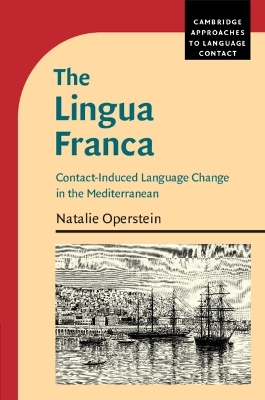
The Lingua Franca
Contact-Induced Language Change in the Mediterranean
Seiten
2024
Cambridge University Press (Verlag)
978-1-108-99985-4 (ISBN)
Cambridge University Press (Verlag)
978-1-108-99985-4 (ISBN)
Whose name is hidden behind the anonymity of the key publication on Mediterranean Lingua Franca? What linguistic reality does the label 'Lingua Franca' conceal? These and related questions are explored in this new book on an enduringly important topic, creating new avenues for multi-disciplinary research on Mediterranean languages and history.
Whose name is hidden behind the anonymity of the key publication on Mediterranean Lingua Franca? What linguistic reality does the label 'Lingua Franca' conceal? These and related questions are explored in this new book on an enduringly important topic. The book presents a typologically informed analysis of Mediterranean Lingua Franca, as documented in the Dictionnaire de la langue franque ou petit mauresque, which provides an important historical snapshot of contact-induced language change. Based on a close study of the Dictionnaire in its historical and linguistic context, the book proposes hypotheses concerning its models, authorship and publication history, and examines the place of the Dictionnaire's Lingua Franca in the structural typological space between Romance languages, on the one hand, and pidgins, on the other. It refines our understanding of the typology of contact outcomes while at the same time opening unexpected new avenues for both linguistic and historical research.
Whose name is hidden behind the anonymity of the key publication on Mediterranean Lingua Franca? What linguistic reality does the label 'Lingua Franca' conceal? These and related questions are explored in this new book on an enduringly important topic. The book presents a typologically informed analysis of Mediterranean Lingua Franca, as documented in the Dictionnaire de la langue franque ou petit mauresque, which provides an important historical snapshot of contact-induced language change. Based on a close study of the Dictionnaire in its historical and linguistic context, the book proposes hypotheses concerning its models, authorship and publication history, and examines the place of the Dictionnaire's Lingua Franca in the structural typological space between Romance languages, on the one hand, and pidgins, on the other. It refines our understanding of the typology of contact outcomes while at the same time opening unexpected new avenues for both linguistic and historical research.
Natalie Operstein's publications include Consonant Structure and Prevocalization (2010), Zaniza Zapotec (2015), Valence Changes in Zapotec (ed. with Sonnenschein, 2015), and Language Contact and Change in Mesoamerica and Beyond (ed. with Dakin and Parodi, 2017). She is a recipient of the National Endowment for the Humanities Fellowship.
Foreword; 1. Introduction; 2. The author; 3. The dictionnaire; 4. The orthography; 5. The lexicon; 6. The word formation; 7. The inflection; 8. The syntax; 9. The lingua franca; Appendix A; Appendix B; Appendix C.
| Erscheinungsdatum | 30.01.2024 |
|---|---|
| Reihe/Serie | Cambridge Approaches to Language Contact |
| Zusatzinfo | Worked examples or Exercises |
| Verlagsort | Cambridge |
| Sprache | englisch |
| Gewicht | 610 g |
| Themenwelt | Geisteswissenschaften ► Geschichte ► Regional- / Ländergeschichte |
| Geisteswissenschaften ► Sprach- / Literaturwissenschaft ► Sprachwissenschaft | |
| ISBN-10 | 1-108-99985-9 / 1108999859 |
| ISBN-13 | 978-1-108-99985-4 / 9781108999854 |
| Zustand | Neuware |
| Informationen gemäß Produktsicherheitsverordnung (GPSR) | |
| Haben Sie eine Frage zum Produkt? |
Mehr entdecken
aus dem Bereich
aus dem Bereich
Erinnerungen
Buch | Softcover (2024)
Pantheon (Verlag)
CHF 22,40


